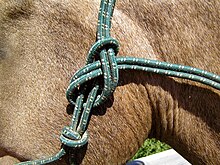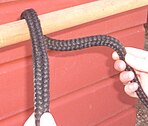Tack is equipment or accessories equipped on horses and other equines in the course of their use as domesticated animals. This equipment includes such items as saddles, stirrups, bridles, halters, reins, bits, and harnesses. Equipping a horse is often referred to as tacking up, and involves putting the tack equipment on the horse. A room to store such equipment, usually near or in a stable, is a tack room.

A gag is a device used in sexual bondage and BDSM roleplay. Gags are usually associated with roleplays involving bondage, but that is not necessarily the case. The person who wears the gag is regarded as the submissive partner, while the other is regarded as the dominant one. People may wear gags for a variety of reasons. Some people derive erotic pleasure from a gag, either in a submissive or dominant role. When combined with other physical restraints, the wearing of a gag can increase the wearer's sense of helplessness and anxiety level within a BDSM scene by rendering them unable to speak during sexual activity, which some people enjoy.

A bridle is a piece of equipment used to direct a horse. As defined in the Oxford English Dictionary, the "bridle" includes both the headstall that holds a bit that goes in the mouth of a horse, and the reins that are attached to the bit. It provides additional control and communication through rein pressure.

Longeing or lungeing is a technique for training and exercising horses. It is also a critical component of the sport of equestrian vaulting.

A noseband is the part of a horse's bridle that encircles the nose and jaw of the horse. In English riding, where the noseband is separately attached to its own headstall or crownpiece, held independently of the bit, it is often called a cavesson or caveson noseband. In other styles of riding, a simple noseband is sometimes attached directly to the same headstall as the bit.
A martingale is any of several designs of tack that are used on horses to control head carriage. Martingales may be seen in a wide variety of equestrian disciplines, both riding and driving. Rules for their use vary widely; in some disciplines they are never used, others allow them for schooling but not in judged performance, and some organizations allow certain designs in competition.

Reins are items of horse tack, used to direct a horse or other animal used for riding. They are long straps that can be made of leather, nylon, metal, or other materials, and attach to a bridle via either its bit or its noseband.
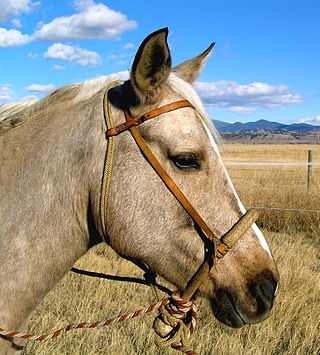
A hackamore is a type of animal headgear which does not have a bit. Instead, it has a special type of noseband that works on pressure points on the face, nose, and chin. Hackamores are most often seen in western riding and other styles of riding derived from Spanish traditions, and are occasionally seen in some English riding disciplines such as show jumping and the stadium phase of eventing. Various hackamore designs are also popular for endurance riding. While usually used to start young horses, they are often seen on mature horses with dental issues that make bit use painful, and on horses with mouth or tongue injuries that would be aggravated by a bit. Some riders also like to use them in the winter to avoid putting a frozen metal bit into a horse's mouth.
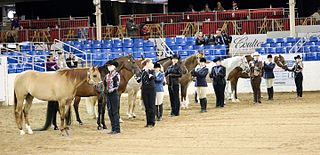
Showmanship is an event found at many horse shows. The class is also sometimes called "Fitting and Showmanship", "Showmanship In-Hand", "Showmanship at Halter" or "Halter Showmanship" It involves a person on the ground leading a horse, wearing a halter or bridle, through a series of maneuvers called a pattern. The horse itself is not judged on its conformation. Exhibitors are judged on exhibiting the animal to its best advantage, with additional scoring for the grooming and presentation of both horse and handler.

The bottle sling is a knot which can be used to create a handle for a glass or ceramic container with a slippery narrow neck, as long as the neck widens slightly near the top.

A mechanical hackamore is a piece of horse tack that is a type of bitless headgear for horses where the reins connect to shanks placed between a noseband and a curb chain. Other names include "hackamore bit", "brockamore", "English hackamore", "nose bridle" and "German hackamore". Certain designs have been called "Blair's Pattern" and the "W. S. Bitless Pelham".
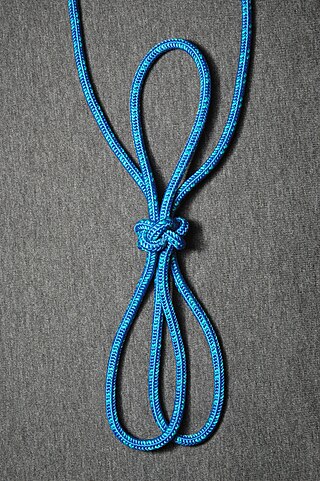
The fiador knot is a decorative, symmetrical knot used in equine applications to create items such as rope halters, hobbles, and components of the fiador on some hackamore designs. As traditionally described, it is a four strand diamond knot in which six of the eight ends loop back into the knot, thus allowing it to be tied with a single line. While a specific knot is discussed in this article, the fiador knot has also been treated as an entire class of multi-strand knots similarly made with a single line.

The bit is an item of a horse's tack. It usually refers to the assembly of components that contacts and controls the horse's mouth, and includes the shanks, rings, cheekpads and mullen, all described here below, but it also sometimes simply refers to the mullen, the piece that fits inside the horse's mouth. The mullen extends across the horse's mouth and rests on the bars, the region between the incisors and molars where there are no teeth. The bit is located on the horse's head by the headstall, and which has itself several components to allow the most comfortable adjustment of bit location and control.

A bosal is a type of noseband used on the classic hackamore of the vaquero tradition. It is usually made of braided rawhide and is fitted to the horse in a manner that allows it to rest quietly until the rider uses the reins to give a signal. It acts upon the horse's nose and jaw. Though seen in both the "Texas" and the "California" cowboy traditions, it is most closely associated with the "California" style of western riding. Sometimes the term bosal is used to describe the entire classic hackamore or jaquima. Technically, however, the term refers only to the noseband portion of the equipment.

Halter is a type of horse show class where horses are shown "in hand," meaning that they are led, not ridden, and are judged on their conformation and suitability as breeding stock. Depending on breed and geographic region, such events may be called "Halter," "In-Hand," "Breeding," "Model," or "Conformation" classes.

A bitless bridle is a general term describing a wide range of headgear for horses or other animals that controls the animal without using a bit. Direction control may also be via a noseband or cavesson, if one is used. The term hackamore is the most historically accurate word for most common forms of bitless headgear. However, some modern bitless designs of horse headgear lack the heavy noseband of a true hackamore and instead use straps that tighten around a horse's head to apply pressure in various ways. These are often specifically patented and marketed as "bitless bridles", usually referencing a particular type of headgear known as the cross-under, though other designs are sometimes also given similar names.

A fiador term of Spanish colonial origin referring to a hackamore component used principally in the Americas. In English-speaking North America, the fiador is known principally as a type of throatlatch used on the bosal-style hackamore. Its purpose is to stabilize a heavy noseband or bosal and prevent the bridle from shifting. It is not used for tying the horse.

A frentera is a part of some halters and bridles, usually on a horse. It is a cord, strap, or chain on the face of the horse that is attached to the crownpiece or browband and runs down the horse's face to the noseband or bit rings. A frentera can be split at the top to pass on either side of the forelock, or on either side of the ears. In the latter case, the frentera usually substitutes for a browband. A frentera can also be split at the bottom into two or more parts to support and stabilize a heavy noseband or bit.
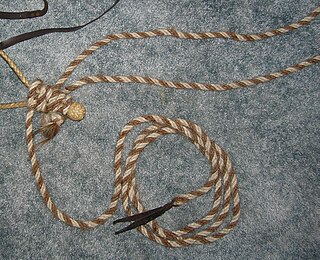
The mecate is the rein system of the bosal style hackamore used to train young horses. It is a long rope, traditionally of horsehair, approximately 20–25 feet long and up to about 3/4 inch in diameter. It is tied to the bosal in a specialized manner that adjusts the fit of the bosal around the muzzle of the horse, and creates both a looped rein and a long free end that can be used for a number of purposes. When a rider is mounted, the free end is coiled and attached to the saddle. When the rider dismounts, the lead rein is not used to tie the horse to a solid object, but rather is used as a lead rope and a form of Longe line when needed.

A lead, lead line, lead rope (US) or head collar rope (UK), is used to lead an animal such as a horse. Usually, it is attached to a halter. The lead may be integral to the halter or, more often, separate. When separate, it is attached to the halter with a heavy clip or snap so that it can be added or removed as needed. A related term, lead shank or lead chain refers to a lead line with a chain attached that is used in a variety of ways to safely control possibly difficult or dangerous horses if they will not respond to a regular lead.










